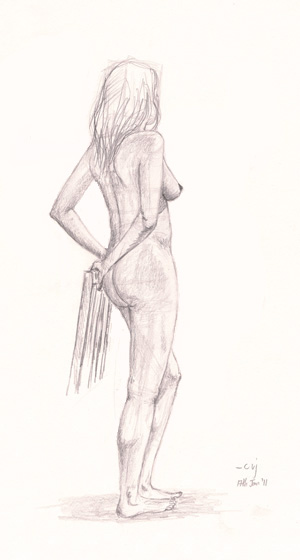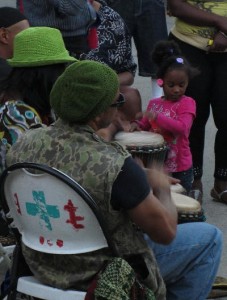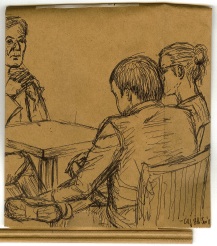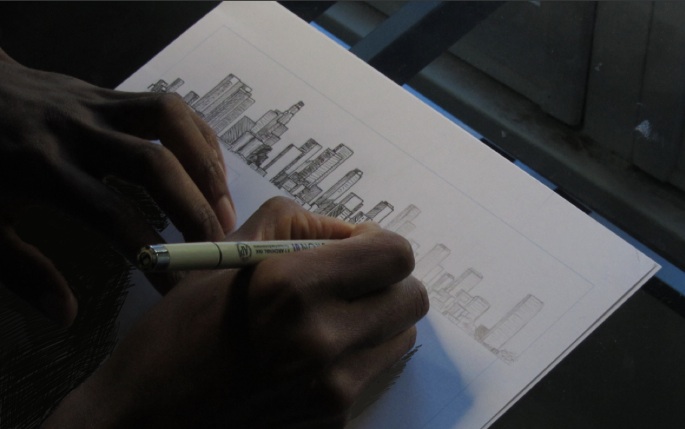The Bells
Another succulent in the garden is flowering. I love these flowers, which stretch way up from the plant itself, right in front of the drawing desk at my study/studio […] Click to continue reading this post
Another succulent in the garden is flowering. I love these flowers, which stretch way up from the plant itself, right in front of the drawing desk at my study/studio […] Click to continue reading this post
 Last Friday, I went to the luncheon of the Los Angeles Institute for the Humanities, and as usual there was a fascinating short talk to accompany lunch and coffee. (As I mentioned before, the membership of this group is a rather wonderful mixture of people mostly from USC, UCLA, and the city of Los Angeles in general, mostly prominent writers, artists, and other people from the humanities, film, theatre, and… they let one or two dabbler-type scientists like yours truly on the list, bless them.)
Last Friday, I went to the luncheon of the Los Angeles Institute for the Humanities, and as usual there was a fascinating short talk to accompany lunch and coffee. (As I mentioned before, the membership of this group is a rather wonderful mixture of people mostly from USC, UCLA, and the city of Los Angeles in general, mostly prominent writers, artists, and other people from the humanities, film, theatre, and… they let one or two dabbler-type scientists like yours truly on the list, bless them.)
The talk was by Bram Dijkstra, and was entitled “The Nude in American Art”. As with most of the talks here (and in many similar venues), it seems to be associated with a book the speaker has out recently, and this one is a sumptuous-looking tome called “Naked: The Nude in America”. It was a nice talk, although he did not get very much into the modern America part because he spent time on the European connections and background and then ran out of time (they try to keep the luncheon talks short and to the point, leaving you wanting more, and leaving time for questions, which is indeed a good thing). However, one of the things that kept coming up was the whole business of an early prudishness or puritanicalism (still persisting in some places today) that meant that the naked physical form should somehow be hidden away. You get examples even today of art galleries’ major donors creating problems for an exhibit that contains nudes, etc., etc. He discussed various changing (and not changing) attitudes to this issue on both sides of the Atlantic through the years, which I found interesting. Aspects of this were not just tied to things like religion, but also the changing status of women in the various societies, to various degrees, since a lot of nudes feature the female form.
This is all very interesting to me in view of The Project for, I hope, obvious reasons. I found myself wondering (and indeed asked a question at the end about it) about […] Click to continue reading this post
A closeup snap of the core of one of my favourite succulents from my garden. It is […] Click to continue reading this post
A student asked a question in the string theory class today to which my answer was a suggestion of how to think about the issue raised in order to go about answering the question themselves. There’d be a few minutes of diagram drawing, and all would (hopefully) be clear. I thought that might not be an unreasonable thing to ask of a student, particularly in a graduate class, where they are ultimately trying to develop skills to do research. Well, it all went a bit pear-shaped as the student seemed to get quite strongly annoyed by this suggestion. I’ve still no idea why.
A nyway, on the bus home I thought I’d do some idle doodling, and ended up doing the exercise I’d suggested… and sure enough what I suggested doing works nicely and does (I think) make it clear.
nyway, on the bus home I thought I’d do some idle doodling, and ended up doing the exercise I’d suggested… and sure enough what I suggested doing works nicely and does (I think) make it clear.
I’m sure it was all a misunderstanding… Probably my fault.
Over late night dinner just now, since I can’t put down this lovely brush pen I’ve been drawing with recently, I scribbled the figures out from the notebook for you to look over my shoulder, as it were, and see what we’re up to in the class. Don’t worry so much about what it all means. It is sometimes nice to just look at the shapes. (Actually, one of the students brought his mother to visit the class today. She sat through the whole hour and fifty minutes of the lecture. That was nice. I hope she enjoyed it all!)
I find these diagrams and the computations they represent rather pretty.
Wednesday will be the big climactic lecture of a sequence I’ve been leading them […] Click to continue reading this post
So, a huge number of decisions went into getting the work to where I wanted it to be, and I’ve shown you samples in various previous posts, some collected here. But where does it all begin? It starts with the idea or concept that I am thinking about, and conversations which will form the dialogue for the piece in question. I start fleshing it out more, perhaps with a setting beginning to form in my mind. Maybe pencil drawings begin to take shape, and I start laying out pages, capturing the beats of the conversation, and the visuals that might get used. Characters (the people who will be in dialogue) begin to assert themselves by this point as well.
Incidentally, this is a place where sometimes the iPad comes into its own, and it is a great tool at several stages of all this. This project is one of the reasons I got the iPad, although I could not tell you at the time I got it back in the early Summer since I was not revealing what I was working on then. (Much of the other stuff I happily discovered about the iPad that I blogged about a while back (here, here, and here) are actually nice bonuses. I got it primarily to help me with development aspects on this project that had little to do with those other features.) I draw rough layouts on the iPad sometimes, and I can store all my rough ideas and print them out, modify them, call them up for later viewing, and so forth. I can carry work in progress with me, reference photos from location scouting, etc. It is also good for practice sketching, and sometimes, using it, I’ve grabbed some nice quick drawings of people in a meeting or in a bar or on a bus. Drawing from life is an important skill to keep up. The iPad is not used in final production on the graphic novel though. I work at a level of detail and complexity that the iPad would not be able to […] Click to continue reading this post
 I just saw on the USC news site that DJ Strouse, one of our excellent current physics majors, has been selected as one of 14 students in the USA to get a Churchill Scholarship this year! He is the first USC student to get one, actually. DJ is one of those students who reminds you why teaching is such a delight. He engages with the material in class and beyond, exploring it extensively on his own, and […] Click to continue reading this post
I just saw on the USC news site that DJ Strouse, one of our excellent current physics majors, has been selected as one of 14 students in the USA to get a Churchill Scholarship this year! He is the first USC student to get one, actually. DJ is one of those students who reminds you why teaching is such a delight. He engages with the material in class and beyond, exploring it extensively on his own, and […] Click to continue reading this post
The hankering I had for some marmalade on fresh bread on Sunday last was satisfied a bit later by simply making some. It was a lot of fun. I always like making bread as it […] Click to continue reading this post
 This always catches people off guard (myself included), so I thought I’d post a little reminder. The deadline for applications to the Summer workshops at the Aspen Center for Physics is January 31st. That’s coming up soon, so to physicists interested in doing a research stay, start thinking about the dates you want to attend, finding funds for support, planning for things like childcare or summer programs for children if you have any, and so on and so forth. There’s a wide variety of excellent […] Click to continue reading this post
This always catches people off guard (myself included), so I thought I’d post a little reminder. The deadline for applications to the Summer workshops at the Aspen Center for Physics is January 31st. That’s coming up soon, so to physicists interested in doing a research stay, start thinking about the dates you want to attend, finding funds for support, planning for things like childcare or summer programs for children if you have any, and so on and so forth. There’s a wide variety of excellent […] Click to continue reading this post
 After working for most of the day on various things (finishing penciling, then inking, and partly painting a panel for one of the pages of The Project, writing a letter of recommendation, answering various emails, etc.,) I decided to go out and enjoy the wonderful day that we were having here in LA for Martin Luther King Jr. Day. I opted to head to Leimert Park and check out one of the primary (post-parade) celebrations going on in the city. That part of town is regarded by many as a cultural center for the African American community in LA, and a lot of great celebrations and other gatherings are held there from time to time (there’s also good music to be found there sometimes). As I walked along in observer mode, I noticed a group of drummers. Every now and again they’d get a groove going and people would gather around and some would start moving to the sounds, some swaying in place, some dancing outright. Young and old, male and female, black and white, etc. It was good to watch. I caught a snippet for you and it is linked below. […] Click to continue reading this post
After working for most of the day on various things (finishing penciling, then inking, and partly painting a panel for one of the pages of The Project, writing a letter of recommendation, answering various emails, etc.,) I decided to go out and enjoy the wonderful day that we were having here in LA for Martin Luther King Jr. Day. I opted to head to Leimert Park and check out one of the primary (post-parade) celebrations going on in the city. That part of town is regarded by many as a cultural center for the African American community in LA, and a lot of great celebrations and other gatherings are held there from time to time (there’s also good music to be found there sometimes). As I walked along in observer mode, I noticed a group of drummers. Every now and again they’d get a groove going and people would gather around and some would start moving to the sounds, some swaying in place, some dancing outright. Young and old, male and female, black and white, etc. It was good to watch. I caught a snippet for you and it is linked below. […] Click to continue reading this post
Yesterday I had a hankering for marmalade. Perhaps with bits of ginger in it. Maybe a bit of whisky. On fresh bread. […] Click to continue reading this post
Although the planning of a panel on a page is entirely freehand pencil or pen work, it is indeed the case that sooner or later I start detailed placing of subjects, and I often use perspective to do the layouts. Not just for skyscrapers and so forth, but for down to earth things too. I do it the old-fashioned way, which is repetitive and time-consuming, but I must admit – It is fun! Take some time to look at everything around you – real or represented in drawings, photos, etc – and you’ll likely see perspective cues that help give sense of depth and placing. It is all about geometry, which our universe seems to like a lot, and which we use to navigate in it. Learning a bit of this geometry, and how to build it in projection in two dimensions on the page (and it is much easier than this sentence makes it sound!) allows one to make reasonably convincing recreations of the universe (or simulacra of your choosing) and how we perceive it. Real artists (not hacks like yours truly) use geometry a lot, in one way or another, to interpret, represent, or distill aspects of the world, and so in a sense, they are companions on the same road as those of us in (especially) the physical sciences.
Babble aside, here you can see parts of the interior of a cafe taking shape. I did it using three-point perspective*:
This will be the skeleton upon which I build the flesh of the rest of the piece. It is based on my knowledge of a real cafe that I location-scouted (well, I happen to drink coffee there from time to time), but you’d never get this view without (a) perhaps being able to fly, and (b) removing the ceiling. Trying to be somewhat discreet in this […] Click to continue reading this post
 Mum’s upstairs packing to leave after her lovely visit of a month and I’m already upset by this. It was such a great time, and I’m so very sad to see her go*. But I can’t keep her all to myself. My sister and brother will no doubt be expecting her back by now, and so I must give her up. 🙂 This blog post is a lame attempt to distract myself from her packing activity, which is a bit sad for me. On the other hand, a rather sweet aspect of it is that I can hear her in the distance singing along to songs from Queen’s A Night At The Opera** and other albums while doing her packing. This makes me smile from ear to ear.
Mum’s upstairs packing to leave after her lovely visit of a month and I’m already upset by this. It was such a great time, and I’m so very sad to see her go*. But I can’t keep her all to myself. My sister and brother will no doubt be expecting her back by now, and so I must give her up. 🙂 This blog post is a lame attempt to distract myself from her packing activity, which is a bit sad for me. On the other hand, a rather sweet aspect of it is that I can hear her in the distance singing along to songs from Queen’s A Night At The Opera** and other albums while doing her packing. This makes me smile from ear to ear.
The last few days had lots of activities, including more picnics by the seaside, walks, cooking, shopping, visits to some old favourite haunts (including a surprise Sunday […] Click to continue reading this post
Well, today was the first lecture of the string theory course (part 2) that I mentioned in the previous post. And I applied the “when they think you’re going to zig, you zag” principle. They have been expecting me to dive into the whole business of open strings and D-branes and so forth (the subject of the book), and I did not. Sure, that will come, and sure, we’ll explore what they mean and what they can tell us about string theory beyond perturbation theory and so on and so forth. But I want first to spend a couple of weeks on getting to the heart of the matter. They made several standard choices along the way in doing their first semester of study of string theory. What did they mean? Why did they work? Were those the only choices? What is underlying a lot of it all, and what, when stripped down to the essence, is at the core of string perturbation theory and beyond? In other words, let’s look more closely at the path integral definition (such as it is) of a string theory (slightly schematically):
[tex] Z=\int [{\cal D}g {\cal D}X] e^{-S(X,g)}\ ,[/tex]
and make sense of all the bits. (Er, for the two of you still reading, [tex]S(X,g)[/tex] is an […] Click to continue reading this post
I’m feeling strangely cold, although the heating is on and I’ve got a jumper (“sweater” to readers in the States) on. It has been this way all day, so I suspect it is something to do with my frame of mind. I’m feeling a bit reflective with it too, so I’ll think out loud (as it were) a bit before going to bed early.
Well, it is almost time to start another round of teaching. This semester, starting Monday, it is a graduate course that I’ll be teaching, the second part of a year’s sequence of string theory that we teach from time to time. My focus will be non-perturbative issues, focusing on much of what has been forming the foundation of research in various areas of string theory since the 1990s. Should be fun. Some of the material will come from my book, D-branes, that was published back in 2002. It seems so long ago now. I actually looked in it today, as I was discussing a research issue with a colleague, and could not recall some details. Happily there was a chapter with it all in there. That’s rather nice. The book serves me well as a personal reminder of things I used to have at my fingertips all the time back then, and as a bonus, lots of people around the world still use it as a handbook/guide/intro/etc, I hear.
I joke, of course. The cart and the horse are the other way around.
Speaking of books, I’ll be doing my best to continue working on the current book project, with all the excitement and adventure in developing it. (And the occasional […] Click to continue reading this post
 Remember the skyline in an earlier post? Well, I forgot that I’d taken a snap of myself doing the inks for it last month, knowing that I’d ultimately be sharing it with those of you curious about the process. So there you can see me about half way, inking with a cartridge ink pen on the 11 in. x 17 in. Bristol artboard where it sits as a sort […] Click to continue reading this post
Remember the skyline in an earlier post? Well, I forgot that I’d taken a snap of myself doing the inks for it last month, knowing that I’d ultimately be sharing it with those of you curious about the process. So there you can see me about half way, inking with a cartridge ink pen on the 11 in. x 17 in. Bristol artboard where it sits as a sort […] Click to continue reading this post